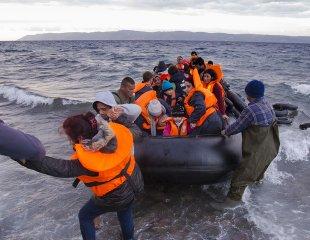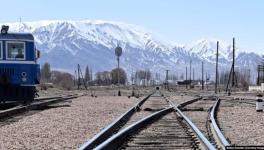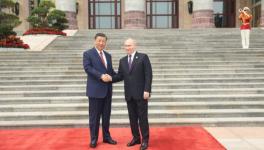By 2020, Refugees Would Be the Most Populous Country on Earth

Image Courtesy: Nicolas Economou / Shutterstock.com
The UN Refugee Agency has announced the new figures for the world’s displaced: 65.9 million. That means that 65.9 million human beings live as refugees, asylum seekers or as internally displaced people. If the refugees formed a country, it would be the 21st largest state in the world, just after Thailand (68.2 million) and just ahead of the United Kingdom (65.5 million). But unlike these other states, refugees have few political rights and no real representation in the institutions of the world.
The head of the UN Refugee Agency, Filippo Grandi, recently said that most of the displacement comes as a result of war. "The world seems to have become unable to make peace," Grandi said. "So you see old conflicts that continue to linger, and new conflicts erupting, and both produce displacement. Forced displacement is a symbol of wars that never end."
Few continents are immune from the harsh reality of war. But the epicenter of war and displacement is along the axis of the Western-driven global war on terror and resource wars. The line of displacement runs from Afghanistan to South Sudan with Syria in between. Eyes are on Syria, where the war remains hot and the tensions over escalation intensify daily. But there is as deadly a civil war in South Sudan, driven in large part by a ferocious desire to control the country’s oil. Last year, 340,000 people fled South Sudan for refugee camps in neighboring Uganda. This is a larger displacement than from Syria.
Poverty is a major driver of displacement. It is what moves hundreds of thousands of people to try and cross the Sahara Desert and then the Mediterranean Sea for European pastures. But most who try this journey meet a deadly fate. Both the Sahara and the Mediterranean are dangerous. This week, the UN’s International Organisation for Migration (IOM) in Niger rescued 600 migrants from the Sahara, although 52 did not survive.
A 22-year-old woman from Nigeria was among those rescued. She was on a pick-up truck with 50 people. They left Agadez for Libya. ‘We were in the desert for ten days,’ she says. "After five days, the driver abandoned us. He left us with all of our belongings, saying he was going to pick us up in a couple of hours. But he never did." Forty-four of the migrants died. The six who remained struggled to safety. ‘We had to drink our own pee to survive,’ she said.
Getting to Libya is hard enough. But being in Libya is perilous. Violence against vulnerable migrants inside Libya continues to occur. The IOM reports the presence in Libya of ‘slave markets.’ Migrants who make it across the Sahara into Libya have told investigators that they find themselves in these slave markets where they are bought to be taken to private prisons and put to work or else sold back to their families if they can raise the high ransom payments. UNICEF reports incidents of rape and violence against women and children in these private prisons. One 15-year-old boy said of his time in a private prison, "Here they treat us like chickens. They beat us, they do not give us good water and good food. They harass us. So many people are dying here, dying from disease, freezing to death."
Danger lurks on the sea as well. This year already IOM reports least 2,108 deaths in the sea between Libya and Italy. This is the fourth year in a row that IOM has counted over 2,000 deaths by mid-year. Over the past five years, this averages out to about 10 deaths a day. Libya, broken by NATO’s war in 2011, remains a gateway for the vulnerable from various parts of Africa, countries damaged by IMF policies and by warfare. There is no expectation that the numbers of those on the march will decrease.
In a recent paper in The Lancet (June 2017), Paul Spiegel, formerly of the UN Refugee Agency suggests that the "humanitarian system was not designed to address the types of conflicts that are happening at present." With over 65 million people displaced, the various institutions of the UN and of the NGO world are simply not capable of managing the crisis.
"It is not simply overstretched," Spiegel wrote of the humanitarian system, "it is no longer fit for purpose."
These are shattering words. One problem Spiegel identifies is the assumption that refugee flows are temporary, since wars will end at some point. What happens when wars and occupations are permanent? People either have to live for generations in refugee camps or they will seek, through dangerous passages, flight to the West. He gives the example of Iran, which absorbed over a million Afghan refugees without using the camp strategy. They simply allowed the Afghans into Iranian society and absorbed them by putting money into their various social schemes (such as education and health). Spiegel also points out that refugees must be part of the designing the process for humanitarian aid. These are good suggestions, but they are not going to be possible with the limited funds available for refugees and with the crisis level of activity that detains the humanitarian agencies.
Spiegel does not deal with one of the great problems for humanitarianism: the persistence of war and the theory that more war—or the current euphemism, security—is the answer to humanitarian crises. This January, over 1,000 people tried to scale the large barrier that divides Morocco from the Spanish enclave of Ceuta. Looking at that barrier, one is reminded of the idea that walls will somehow prevent migration, a view driven by President Donald Trump. Violence met the migrants, a mirror of the violence that was visited among migrants along the spinal cord of Eastern Europe last year. Walls, police forces and military interventions are all seductive to an imagination that forgets why people migrate and that they are human beings on the run with few other options. There is a view that security barriers and security forces will raise the price of migrant and deter future migrants. This is a silly illusion. Migration is dangerous already. That has not stopped anyone. More humane thinking is necessary.
It is important therefore that the UN Deputy Secretary-General Amina Mohammed told a meeting on the Sahel on June 28 that the world leaders need to "avoid a disproportionate emphasis on security" when dealing with the multiple crises in the Sahara region and north of it. "No purely military solution" can work against transnational organized crime, violent extremism and terrorism, nor against poverty and hopelessness. Underlying causes are not being addressed, and indeed the surface reactions—to bomb more—only create more problems, not less.
In the July issue of Land Use Policy, professors Charles Geisler and Ben Currens estimate that by 2100 there will be 2 billion refugees as a result of climate change. These numbers are staggering. They are an inevitable future. By then, refugees will be the largest country on earth—nomads, seeking shelter from destruction of climate and capitalism, from rising seas and wars of greed.
Disclaimer: The views expressed here are the author's personal views, and do not necessarily represent the views of Newsclick.
Get the latest reports & analysis with people's perspective on Protests, movements & deep analytical videos, discussions of the current affairs in your Telegram app. Subscribe to NewsClick's Telegram channel & get Real-Time updates on stories, as they get published on our website.
























